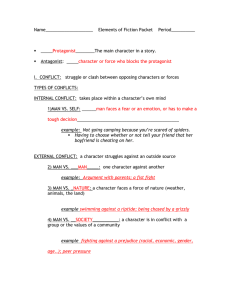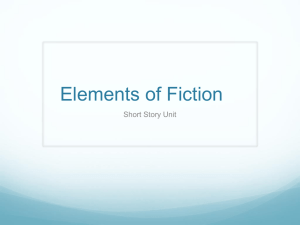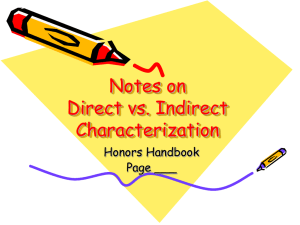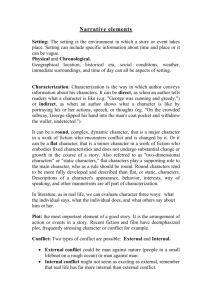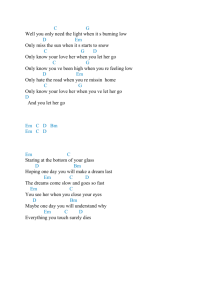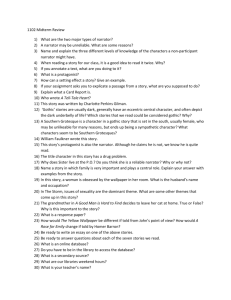Name____________________ Elements of Fiction Packet ... _____ ________The main character in a story.
advertisement
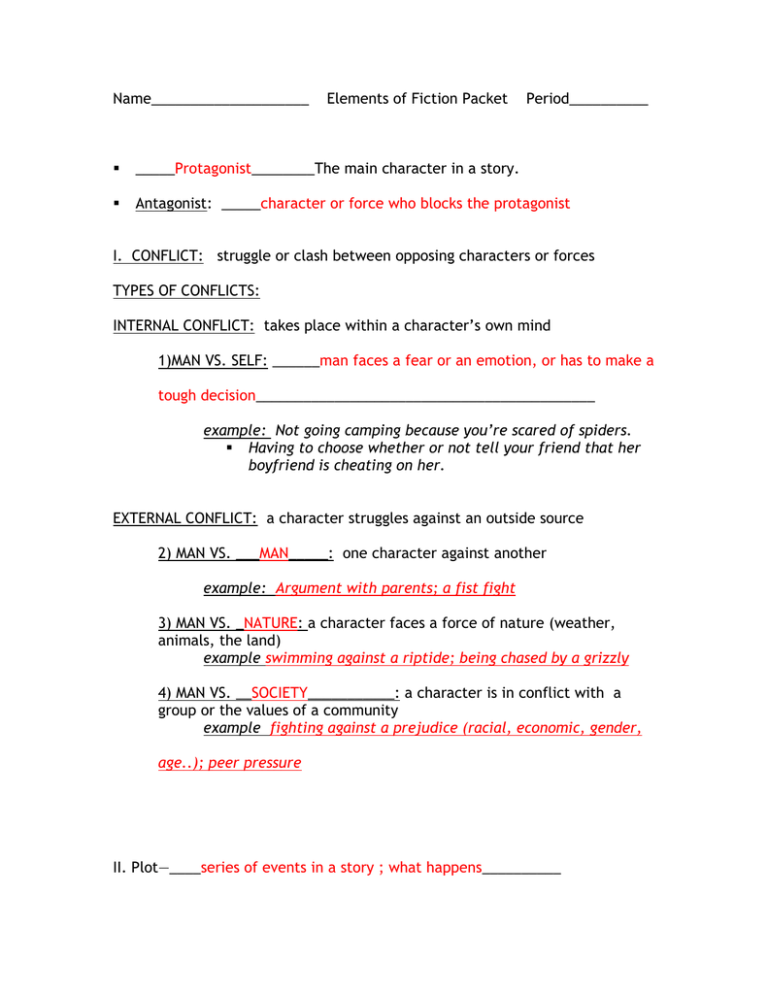
Name____________________ Elements of Fiction Packet Period__________ _____Protagonist________The main character in a story. Antagonist: _____character or force who blocks the protagonist I. CONFLICT: struggle or clash between opposing characters or forces TYPES OF CONFLICTS: INTERNAL CONFLICT: takes place within a character’s own mind 1)MAN VS. SELF: ______man faces a fear or an emotion, or has to make a tough decision___________________________________________ example: Not going camping because you’re scared of spiders. Having to choose whether or not tell your friend that her boyfriend is cheating on her. EXTERNAL CONFLICT: a character struggles against an outside source 2) MAN VS. ___MAN_____: one character against another example: Argument with parents; a fist fight 3) MAN VS. _NATURE: a character faces a force of nature (weather, animals, the land) example swimming against a riptide; being chased by a grizzly 4) MAN VS. __SOCIETY___________: a character is in conflict with a group or the values of a community example fighting against a prejudice (racial, economic, gender, age..); peer pressure II. Plot—____series of events in a story ; what happens__________ 1. __ Exposition_____—characters, setting, and conflict introduced 2. __Rising Action______— The conflict and situation becomes more complicated and intense; sometimes more conflicts arise 3. ________Climax_______—The highest point of action and suspense; the turning point 4. ____Falling Action___—Events that happen after the turning point that lead to the eventual outcome of the story 5. ______Resolution____—The outcome of the conflict and what follows Draw and label a plot graph in the space below: **_____Foreshadowing____—clues that hint at events that will happen later in the story example: **_______Irony______________-- when the opposite of what is expected occurs example: III. CHARACTERIZATION: the way the author describes his characters 1) Direct Characterization—_______When an author directly states or TELLS what character is like, leaving no guesswork for the reader. Example Hank is clumsy. 2) Indirect Characterization—When the author gives us hints to help us INFER what the character is like. Clues include 1) character’s appearance and body language 2)character’s actions 3) character’s thoughts or feelings 4)character’s words 5) other character’s opinions/reactions 6) the setting Example IV. CHARACTER TYPES: 1)_____FLAT________ character—A character who is not described in great detail and only has one character trait Example : Cindy Lou Who’s dad 2)_____ROUND_______ character—A character who is well-developed; we can list several details about round characters. Example: The Grinch Draw a picture or symbol to illustrate the difference between flat and round characters: 3) STATIC character—a character whose personality or values does not change example: stepsisters in Cinderella; start evil and end evil S=stays the same 4) Dynamic character—___character whose values or personality changes during the story example The Grinch: starts grouchy and hating Christmas; ends cheerful and supports the idea of Christmas. (D=Different) Draw a picture or symbol to illustrate the difference between static and dynamic characters: V. SETTING : the time, place, and mood (feeling given to reader) of a story example: Woods, springtime, threatening mood VI. ______THEME______: the underlying message of a story—what the author wants us to learn. It should be stated in a full sentence—not one word. Example: Red Riding Hood: People often take advantage of others’ trust. Cinderella: True love finds a way. VII. POINT OF VIEW: perspective from which a story is told; the narrator A) 1st Person—_____a character tells the story; uses “I” example: “I was walking down the road and saw two men staring into a house” B)__3rd person limited___—an outside narrator (not a character) tells the story but is limited into seeing ONLY the main character’s head example: Claire was walking down the road and saw two men staring into a house. She was immediately suspicious and thought, “I should call the cops.” 3rd person omniscient C) _ —an all-knowing narrator tells the story; he knows ALL characters’ thoughts and feelings example: Claire was walking down the road and saw two men staring into a house. She was immediately suspicious and thought, “I should call the cops.” Joe saw her staring at him and his brother. He could tell she thought they were up to no good. “I hope she knows this our sister’s house,” he thought.
